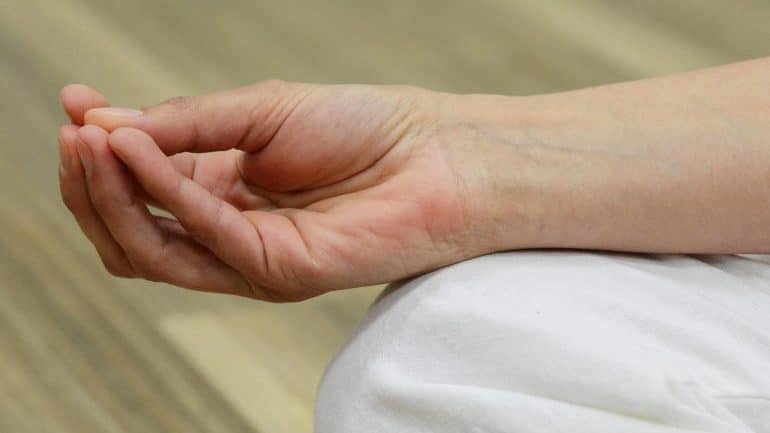27 Meditation Statistics for Your Well-Being in 2024
written by / January 3, 2022
Meditation is a set of techniques used to develop mindfulness, promote calmness, and increase relaxation. As the latest meditation statistics show, its popularity is skyrocketing, with more and more people meditating on a regular basis. In today’s stress-packed world, it’s no wonder people are looking for new ways to relieve stress and anxiety.
But this isn’t meditation’s only benefit. Many studies suggest that this mind and body practice may reduce blood pressure, relieve pain, lower the risk of depression, and enhance overall well-being. Read on to find out more about current meditation trends.
The Top Mind-Blowing Meditation Statistics for 2024
- It’s estimated that 200–500 million people meditate worldwide.
- Over 14% of Americans have meditated at least once.
- Meditation improves anxiety levels 60% of the time.
- Meditation can reduce the risk of being hospitalized for coronary disease by 87%.
- Meditation can reduce the wake time of people with insomnia by 50%, according to mindfulness meditation stats.
- 66% of US Buddhists meditate at least once a week.
- Almost 10 times more children used meditation in 2017 than they did in 2012.
- 52% of employers provided mindfulness classes or training to their employees in 2018.
- Meditation can increase employees’ productivity by 120%.
- School suspensions were reduced by 45% thanks to meditation.
The Growing Popularity of Meditation

Meditation is becoming more and more prevalent as the years go by. Here, we’ll be discussing the popularity of mindfulness.
1. It’s estimated that 200–500 million people meditate worldwide.
(The Good Body)
In recent years, the meditation stats show that the practice has been gaining in popularity. Considering all the health benefits it offers, it’s no surprise that an increasing number of people use it.
2. Over 14% of Americans have meditated at least once.
(The Good Body)
Additionally, Pew Research Center’s research indicates that this percentage could actually be much higher, with 40% of US adults meditating at least once a week.
3. In 2017, 14.2% of US adults said that they’d meditated in the past 12 months.
(CDC)
The CDC’s report “Use of Yoga, Meditation, and Chiropractors Among U.S. Adults Aged 18 and Older” is a great source of relevant statistics on meditation. According to its findings, the percentage of people who use meditation has increased considerably from 2012, when only 4.1% of Americans had meditated the previous year.
The report’s authors explained this sharp rise by an increase in the number of meditation and yoga cellphone apps. Additionally, there are more and more companies and schools offering yoga and meditation classes to their employees and students.
Benefits of Meditation
You’ve likely heard of ways that meditation can benefit you. In this section, we’ll be focusing on the positive effects of meditation.
4. The majority of people practice meditation to improve their general wellness.
(The Good Body)
About 76% of people using meditation said that general wellness is their primary motive. Furthermore, mindfulness meditation statistics show that other reasons for meditating include boosting energy levels (60%), improving memory and focus (50%), and relieving anxiety, stress, and depression.
5. Meditation improves anxiety levels 60% of the time.
(Project Meditation)
After meditating for 6–9 months, almost two-thirds of those prone to anxiety managed to reduce their anxiety levels.
6. Meditation can reduce the risk of being hospitalized for coronary disease by 87%.
(Project Meditation)
Meditation studies reveal that people who meditate are less likely to suffer from heart disease. Since meditation is a kind of relaxation technique, it relieves stress, which is a well-known cause of many serious medical conditions.
7. Meditation relieves the symptoms of insomnia 75% of the time.
(Project Meditation)
The majority of people with insomnia who meditated on a daily basis were able to fall asleep more quickly. In fact, 75% of them needed only up to 20 minutes to doze off. Additionally, 91% of insomniacs reduced or eliminated their use of sleeping medication.
8. Meditation can reduce PMS symptoms by 57%.
(Meditation 24-7)
Based on meditation research articles, women practicing meditation noticed a reduction in both the physical and psychological PMS symptoms.
9. Meditation can reduce the wake time of people with insomnia by 50%.
(NCBI)
Based on the research examining how effective mindfulness-based therapy for insomnia is, meditation can positively affect insomniacs.

10. Practicing meditation can have positive effects on relieving back pain issues.
(NCBI)
Mindfulness meditation helped people with back pain improve their ability to do daily tasks by 30%. This is one of the proven physical benefits of meditation, according to mindfulness meditation studies.
11. Mindfulness meditation can reduce symptoms of post-traumatic stress disorder 73% of the time.
(NCBI)
A study examined the effectiveness of mindfulness-based cognitive therapy for treating PTSD in veterans. Considering that 73% of them showed reduced symptoms, further research on the effects of meditation should be conducted.
12. Meditation may lower blood pressure 80% of the time.
(Meditation 24-7)
Scientists have found out that practicing meditation is beneficial for hypertensive patients. According to meditation stats, 80% of them lowered their blood pressure and needed less medication thanks to meditation. Additionally, 16% of them were able to stop taking their medications for hypertension.
13. Practicing meditation can increase your attention span after only 4 days.
(ScienceDirect)
In addition, a study showed that practicing mindfulness meditation for a short time may enhance visuospatial processing, working memory, and executive functioning.
14. Meditation can increase grey matter.
(Online Psychology Degree Guide)
According to a Harvard study, practicing mindfulness meditation for at least 30 minutes a day can increase grey matter in the hippocampus. This is one of the more important meditation facts since this part of the brain plays an important role in memory and learning.
Demographics of Meditation Users
Who are the people who meditate? Here, we’ll be looking at the different types of people who make use of meditation.
15. There’s a greater number of women who meditate than men.
(NCCIH)
According to the 2017 National Health Interview Survey, 16.3% of women used meditation compared to 11.8% of men.
16. 15.2% of white adults used meditation in 2017.
(National Center for Health Statistics)
They were more likely to use meditation compared to black (13.5%) and Hispanic (10.9%) adults. This shows that in the case of meditation, its popularity varies across different population groups.
17. Adults aged 45–64 are the most likely to use meditation.
(National Center for Health Statistics)
15.9% of adults in this age group used meditation in 2017 compared to 13.4% of adults in both the 18–44 and 65+ age groups.
18. 66% of US Buddhists meditate at least once a week.
(Pew Research Center)
This fact may not come as a surprise. However, Americans across other religious groups also practice meditation on a regular basis. For example, 49% of Evangelical Protestants meditate at least once a week, while the percentage of Jehova’s Witnesses doing the same is even greater, at 77%. According to these meditation facts and statistics, even about 25% of people who don’t belong to any religion and don’t declare themselves as atheists practice meditation just as frequently.
Meditation and Children

Do children meditate and can it help them? Here, we’ll be answering those questions and more.
19. Almost 10 times more children used meditation in 2017 than they did in 2012.
(National Center for Health Statistics)
In 2017, 5.4% of children aged 4–17 had meditated in the past twelve months, compared to 0.6% in 2012. The percentage of boys and girls who used meditation was very similar.
20. A higher percentage of children aged 12–17 used meditation compared to younger children.
(National Center for Health Statistics)
When it comes to teens, the meditation statistics from 2018 reveal that 6.5% of older children used meditation compared to 4.7% of children aged 4–11. There were no significant differences in the use of meditation among different races.
The Meditation Industry
In this section, we’ll be looking at the history of mediation and how it has evolved over the years.
21. Headspace, a meditation app, has had about 40 million downloads.
(The Good Body)
According to Apple, mindfulness apps, including meditation apps, were the number one app trend in 2018.
22. The meditation and mindfulness industry earned almost $1 billion in 2015.
(Fortune)
However, this piece of meditation industry statistics doesn’t include the revenue from mindfulness apps or the wearable gadgets used during meditation.
23. By 2022, the value of the US meditation market will be a bit over $2 billion.
(Marketdata Enterprises)
According to Marketdata’s findings, the value of the meditation market rose from $959 million to $1.08 billion in just one year, from 2015 to 2016. It’s estimated that its annual growth will average 11.4%.
Meditation at Work or School
Can meditation help learners and workers? We’ll be taking a closer look at meditation in schools and workplaces.
24. 52% of employers provided mindfulness classes or training to their employees in 2018.
(Forbes)
This piece of information comes from an annual survey carried out by the National Business Group on Health (NBGH). Comparing the NBGH’s meditation workplace statistics, this marks a considerable increase—from 36% in 2017 to 52% in 2018.
25. Meditation can increase employees’ productivity by 120%.
(Project Meditation)
Additionally, employers who introduced meditation to their employees claim that work absenteeism decreased by 85% while profits increased by 520%.
26. Meditation was part of the curriculum in 91 US schools in 2012.
(The Good Body)
More and more schools are introducing meditation as part of their curriculum because of its numerous benefits. Among other things, it can reduce class absences and aggressive behavior.
27. School suspensions were reduced by 45% thanks to meditation.
(The Good Body)
One school noticed a decrease in school suspensions after introducing a meditation program. This data on meditation in schools and the statistics related to it are further proof that meditation can be beneficial in the classroom since it’s believed that it can boost children’s performance.
Conclusion
From improving heart health to relieving back pain to boosting our memory, meditation offers a wide range of health benefits. Additionally, it helps us relax, decrease our stress levels, deal with anxiety, and sleep better. With this in mind, it’s not a surprise that the meditation statistics show how this ancient practice is growing in popularity both in the US and in the world.
People are becoming aware of how our stressful lifestyles negatively affect our physical and mental states, so they’ve started looking for new ways to get peace of mind. And meditation is just perfect for helping you achieve inner peace.








